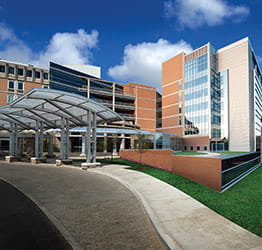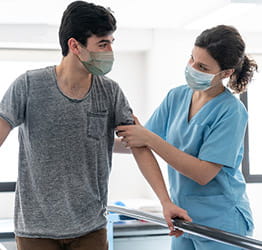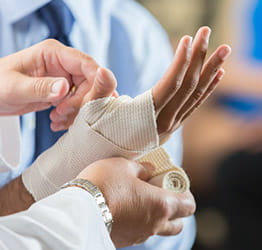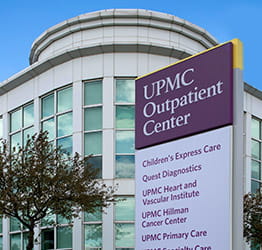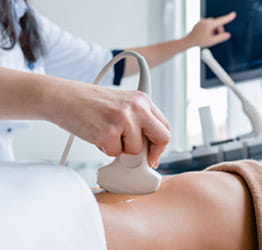If your mammogram or breast ultrasound shows a suspicious area of breast tissue, you may need a minimally invasive breast biopsy.
A minimally invasive breast biopsy is a specialized test that uses radiographic and ultrasound imaging technology to precisely locate suspicious areas of breast tissue so samples can be removed and examined for signs of cancer. A breast radiologist or surgeon performs the biopsy, and a pathologist analyzes the tissue samples in the laboratory.
UPMC breast imaging experts use the most advanced technology to provide minimally invasive diagnostic care. Our leading-edge needle biopsy techniques allow our breast biopsy team to deliver the fast, accurate results you need.
What Is A Minimally Invasive Breast Biopsy?
A minimally invasive breast biopsy is a specialized test that uses radiographic and ultrasound imaging technology to accurately identify suspicious areas of breast tissue so samples can be removed and examined for signs of cancer. A breast radiologist or surgeon performs the biopsy, and a pathologist analyzes the tissue samples in the laboratory.
You may need a minimally invasive breast biopsy if your mammogram or breast ultrasound shows a suspicious area of breast tissue.
Benefits of minimally invasive breast biopsy
Minimally invasive breast biopsy may offer benefits including:
- A shorter recovery time and return to daily activities.
- Advanced treatment planning.
- Minimal scarring due to a small incision.
- Potentially lower hospital costs.
- Reduced pain and risk of infection after the procedure.
What Conditions Do We Diagnose?
We use minimally invasive breast biopsy to diagnose a range of cancerous and noncancerous breast conditions, including:
- Atypical ductal hyperplasia.
- Atypical lobular hyperplasia.
- Breast cancer.
- Breast cysts.
- Fibroadenomas.
- Fibroepithelial lesion.
- Flat epithelial atypia.
- Intraductal papilloma.
- Lobular carcinoma-in-situ.
- Microcalcifications.
- Mucocele-like lesion.
- Phyllodes tumor.
- Radial scar.
Who’s Eligible for Minimally Invasive Breast Biopsy?
You may be a candidate for minimally invasive breast biopsy if you have a suspicious area of breast tissue and your doctor recommends taking a sample for testing in a lab.
What Minimally Invasive Breast Biopsy Procedures Do We Offer?
UPMC experts offer all types of minimally invasive breast biopsy procedures, including:
What Can I Expect?
Before: How to prepare for a minimally invasive breast biopsy
Your doctor will give you instructions on how to prepare for your minimally invasive breast biopsy. Your preparation instructions will depend on the type of imaging used during your biopsy.
On the day of your procedure, arrive 30 minutes before your scheduled procedure time. Be sure to bring your photo ID, health insurance card(s), and a written order from your doctor documenting the medical need for the biopsy. Leave valuables like cash and jewelry at home.
You should wear a two-piece outfit (shirt and pants/shorts) and bring a sports bra. Wearing a supportive bra after your procedure can minimize breast movement and discomfort.
If you receive medication to help you relax during the test, you will need to arrange for someone to drive you home from the imaging center. Otherwise, you should be able to drive home and resume normal activities right away.
How long does a minimally invasive breast biopsy take?
A minimally invasive breast biopsy typically takes 45 to 60 minutes.
During your minimally invasive breast biopsy
Upon arrival at the imaging center, your imaging technologist will explain the procedure to you. Depending on the type of biopsy you are having, you may receive an IV that will be used to inject contrast dye into your arm.
During your minimally invasive breast biopsy, your doctor will:
- Use local anesthesia to numb the part of your breast where the biopsy will be performed.
- Use MRI, ultrasound, or mammography imaging as a guide to pinpoint the suspicious area.
- Use a hollow needle to remove several tissue samples from the suspected area.
- Insert a marker to identify the biopsy site for future reference and perform a mammogram to make sure the marker is in the correct place.
- Cover the area with a bandage.
- Send tissue samples to the lab to be checked for cancer.
Recovery after minimally invasive breast biopsy
You should be able to drive home after your breast biopsy procedure and resume your normal activities within a few hours. You may notice some pain, discomfort, or bruising that should improve within seven to 10 days. Your doctor will provide you with detailed instructions about caring for your wound, managing discomfort, and resuming medications and strenuous activities.
Next steps after your minimally invasive breast biopsy
After your minimally invasive breast biopsy, our team will make sure you receive the follow-up care you need.
How will I get my biopsy results?
Our experts understand that waiting for biopsy results can be stressful. It is important to remember that most breast biopsies turn out to be benign (non-cancerous). The nurse will call to inform you of your biopsy results as soon as your results are received from the pathology department. This usually takes two to four business days after your biopsy.
What happens if breast cancer is detected?
If your biopsy indicates cancer, you will be referred to a team of UPMC breast cancer experts for treatment. UPMC is nationally recognized and offers the most advanced treatment options, including surgery, radiation, chemotherapy, hormonal therapies, and complementary therapies.
Physicians specially trained in the management of breast cancer will review your case with you and develop a personalized treatment plan. Our supportive care team can help you and your loved ones manage the many emotions and questions that may arise throughout the diagnosis, treatment, and recovery process.
Why Choose UPMC for Minimally Invasive Breast Biopsy Services?
When you choose UPMC for minimally invasive breast biopsy services, you will receive:
- Access to advanced imaging technology — Our experts use the latest imaging technology to quickly and accurately diagnose a full range of health conditions.
- Convenient imaging services — Imaging appointments are available at multiple locations with hours that fit your schedule.
- Multidisciplinary care — We partner with breast surgeons, medical oncologists, radiation oncologists, breast reconstructive surgeons, and other medical experts to treat breast cancer and other breast conditions.
By UPMC Editorial Staff. Last reviewed on 2025-09-18.





